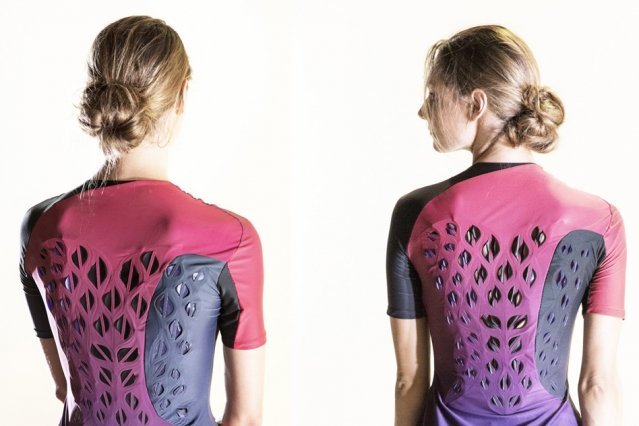MIT has developed breathable clothes and shoes for sports

A team of researchers at the Massachusetts Institute of Technology (MIT) has developed a “breathing” training suit, whose vent valves open and close in response to the body heat and sweat of an athlete. Valves are lined with live microbial cells that shrink and expand in response to changes in humidity. The cells act as tiny sensors and actuators: they force the flaps to open when the athlete starts to sweat, and close them when the body is cold. In addition to the suit, scientists also developed sneakers with an inner layer of similar cellular valves for air and moisture release.
Why use cells in sensitive tissues? Researchers claim that moisture-sensitive cells do not need additional elements for sensing and responding to moisture. It is also proven that the use of microbial cells is safe for skin contact. Moreover, thanks to the tools of genetic engineering available today, a huge number of cells can be prepared very quickly so that they can perform various functions in addition to the response to moisture.
')
To demonstrate this ability, researchers have developed moisture-sensitive cells that not only open the valves, but also highlight in response to changes in humidity. Using genetic techniques, researchers added fluorescence, and in the dark the silhouette of a person running will be noticeable ... In the future, scientists will be able to combine the capabilities of cells with the odor function: after visiting a gym, a sportsman’s shirt or T-shirt will smell sweet.
In nature, biologists have observed that living things and the elements of their structure, from scales to microbial cells and even specific proteins, can change their structure or volume in response to changes in humidity. The MIT team hypothesized that natural shape converters, such as yeast, bacteria, and other microbial cells, can be used as building blocks to create moisture-sensitive tissue.
These cells are so strong that they can bend the substrate on which they are applied. Initially, researchers worked with the most common non-pathogenic E. coli strain (Escherichia coli), which was found to swell and shrink in response to changes in moisture. They additionally designed cells to express green fluorescent protein, allowing the cell to glow when it senses a change in moisture.
Using the cell-printing method, the team applied parallel lines of E. coli cells to latex sheets, making holes in the fabric under conditions of high humidity. When drying on an electric plate, the cells shrank, spinning the upper layer of latex, on a watery couple, the cells glowed and expanded, aligning the latex. According to scientists, after one hundred such cycles, the cell layer and the fabric as a whole almost did not wear out.
In the development of clothing, researchers worked with a biomaterial, designing a running suit with cellular latex valves sewn into the back of the suit. They determined the size of each flap, as well as the degree of their openness, based on images of the human body with heat and sweat deposited on them.
A team of researchers emphasizes that not all parts of the body produce heat and sweat equally. For example, a lot of sweat is produced in the lower part of the spine, but not very much heat. Scientists have redesigned clothing using these "maps": where the body produces more heat, the flaps increased.
The support frames under each patch of latex keep the inner layer of tissue from direct contact with the skin, but at the same time, the cells are able to sense and react to changes in air humidity, directly above the skin. In testing to test a running suit, participants wore clothes and trained on treadmills and bicycles. The researchers monitored the temperature and humidity of the bodies of the subjects, using small sensors on their backs.
After five minutes of exercise, the flaps of the suit began to open just at the moment when the participants in the experiment reported sweating and a feeling of warmth. Sensors showed that the dampers effectively removed sweat and lowered body temperature, unlike a similar running suit with non-functional valves.
Scientists from MIT have also integrated moisture-sensitive fabric into a coarse prototype of shoes. Where the foot touches the insole of the shoe, the researchers sewed a few flaps bent down. The cell layer faces the runner’s foot, but does not touch it. In the design of sneakers, they also focused on foot heat and sweat maps and standard dimensional grids.
As with the sweatsuit, the flaps on the running shoes opened and highlighted when the researchers increased the humidity in the room. In dry conditions, the glow stopped, the shutters closed.
Researchers intend to work with sportswear manufacturers to commercialize their projects. A group of scientists is exploring other areas of technology, including waterproof curtains, lampshades and sheets. In addition, they are interested in rethinking the packaging of goods. The concept of a second skin could give a new life to flexible packaging.
doi: 10.1126 / sciadv.1601984
Source: https://habr.com/ru/post/404067/
All Articles